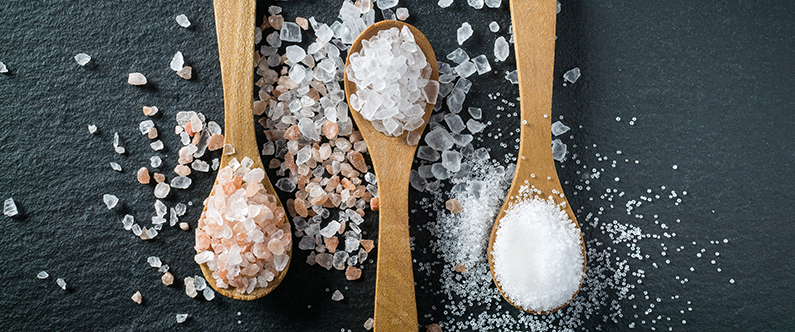Sodium and Salt
 Make informed choices and prioritize health by managing salt intake
Make informed choices and prioritize health by managing salt intake
Authors: Anupama Jithesh, Dr. Sohaila Cheema, Dr. Karima Chaabna, and Salina Khawaja
Salt is widely used to enhance flavor and to preserve food. There are many salt varieties available including table salt, Himalayan pink salt, and sea salt. Himalayan and sea salts are less processed than table salt. However, in terms of amounts of sodium, they are all comparable. Salt is the common name used for the chemical compound sodium chloride, which is a combination of two minerals sodium (40%) and chloride (60%). Many salt varieties are fortified with iodine, iron, or folic acid to help tackle deficiencies.
Sodium contained in salt is crucial for the proper functioning of the human body; however, excessive consumption can lead to adverse health effects like bloating and water retention, high blood pressure, increased risk of kidney disease, osteoporosis, and stomach cancer. The World Health Organization (WHO) recommends that adults limit their daily salt intake to no more than 5 grams, which is approximately equivalent to one teaspoon or 2300 mg of sodium per day.
Although sodium is naturally found in foods such as celery, beet, shellfish, and milk, consuming these does not significantly contribute to excessive intake, because the quantities involved are very small. Excessive sodium intake is often linked to the consumption of processed and restaurant foods, which contain high amounts of added salt for enhancing flavor and preservation. In fact, research shows that more than 70 percent of the sodium in a typical diet is from processed foods, including frozen meals, canned soups, processed meats like bacon, ham, and cheese, as well as salted snacks like crisps, nuts, biscuits, and breakfast cereals. Excess sodium is also found in stock cubes, salted flavorings used during cooking, and in soy or fish sauce added to meals at the table. It is also found in ingredients like monosodium glutamate (MSG), baking soda, baking powder, disodium phosphate, sodium citrate, and sodium nitrate.
Tips for controlling salt intake

Follow these tips to make informed choices and prioritize health by managing your salt intake:
- Avoid or limit consumption of processed foods.
- Eat fruits and vegetables, which are naturally low in sodium and rich in potassium, a nutrient that can help lower blood pressure.
- When buying tinned/canned pulses, vegetables, or fish, choose those that are in water instead of brine (salt water).
- Prepare meals with little salt. Experiment with a diverse range of spices and herbs to enrich flavors without relying on excessive salt. Human taste buds can adjust to lower salt levels over time, enabling you to appreciate a broader spectrum of flavors and enjoy a healthier diet.
- Choose unsalted nuts, plain crackers, vegetable sticks etc. to snack on.
- Mind the labels: Check nutrition labels on food packaging and opt for lower-sodium products. Pay attention to the Nutrition Facts label, and look for products with green color label for salt on the packaging.

Learn the lingo for sodium in food labels
Foods labeled with terms such as “reduced sodium” or “light in sodium” do not necessarily mean they are low in sodium. It just means the products have less sodium than the regular versions of the products. Check out the common sodium claims and what they actually mean in the table below:
| Nutrient content Claim |
What the Claim means |
| Sodium-free or salt-free |
Each serving in this product has less than 5 mg; of sodium |
| Very low sodium |
Each serving has 35 mg of sodium or less |
| Low sodium |
Each serving contains 140 mg of sodium or less |
| Reduced or less sodium |
The product contains at least 25% less sodium than does the regular version |
| Lite or light in sodium |
The sodium content has been reduced by at least 50% from the regular version. But some foods with these labels may still be high in sodium |
| Unsalted or no salt added |
No salt is added during processing of a food that usually contains salt. But some foods with these labels might not be sodium-free. That's because some of the ingredients still may contain sodium |
Source: Mayo Clinic-Nutrition and Healthy Eating
Salt plays a crucial role in our diet, and it is important to be mindful of our sodium intake to maintain good health. However, maintaining a balance is key to avoid health risks associated with excessive sodium consumption. By implementing the tips on controlling salt intake, we can make small yet effective changes to reduce salt intake. For more information, refer to the Qatar Dietary Guidelines.
Sources: WHO | American Heart Association | Mayo Clinic | McGill | Harvard T.H. Chan School of Public Health | Food and Agriculture Organization of the United Nations (FAO)
Edited by: John Hayward